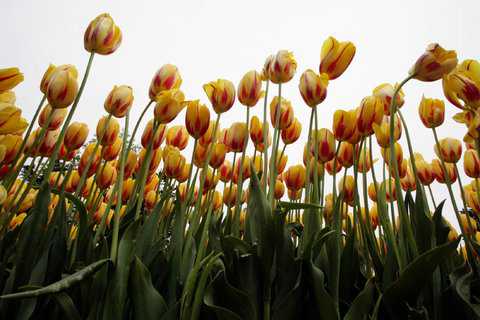Tulips in a public garden in Istanbul.

ISTANBUL — The city’s parks and gardens and the central dividers of its throughways are a blaze of color this month. It’s tulip season, and over 14 million bulbs have burst into bloom, roughly one for every resident. Istanbul still prides itself on having transformed, in the 16th century, this wild hill flower into a cultivated blossom, and with it capturing the imagination of northern Europeans.
But instead of indulging in industrial-scale municipal gardening, local authorities would be better off saving what is left of the city’s once-rich natural habitats.
The history of the Istanbul tulip itself is something of a cautionary tale: There were at least 2,000 individually named varieties in the early 18th century, a period that historians later called the Tulip Age. But not one of these survives, according to the British botanist Andrew Byfield. They were felled by disease and changing fashions.
Most of the tulips now on display around Istanbul are locally grown, but they are large half-cup Dutch hybrids that had to be transplanted back here. (These flowers originated in the steppes of Central Asia, were cultivated in the Ottoman Empire, exported to the Netherlands and then re-imported to Turkey to replace local plants that had died out.) The original Istanbul tulip was a very different beast: “a svelte, almond-shaped flower with long, dagger-like petals tapering to needle-sharp points,” according to the late Turkish botanist Turhan Baytop.
The height of Turkish tulipmania, during the reign of Ahmed III in the early 18th century, was a celebration of the unique and the perfect. Florists would spend the entire year cultivating a single flower. Istanbul will spend just over $7 million on this year’s festival, or roughly half a dollar a tulip. In 1725, a single bulb could change hands for 1,000 gold pieces.
I’m glad that tulips are no longer the fetish exclusively of the elite. But I worry that the display of green-thumbedness at the current festival is camouflage for the wholesale destruction of green spaces elsewhere.
It now seems impossible to stop the construction of a third Bosphorus Bridge at the northern end of Istanbul, a project that will lead to the urbanization of one of the city’s last remaining green belts. And the government has other mega-projects in mind: including a third airport with six runways — it would be the world’s largest — and a grand canal that would cut through the Thracian Peninsula to create another shipping route. Istanbul is also bidding for the 2020 Olympics, which would entail major construction to the west of the city.
Municipal authorities dreaming up these grand plans might pause to ponder the fate of Ahmed III, the sultan who presided over the Tulip Age: He was overthrown, and by some accounts, because of ostentatious tastes he could no longer afford. The logo for Istanbul’s Olympic bid is supposed to represent the outline of Istanbul cupped in a tulip. To me, it looks a lot like a Venus flytrap about to swallow the whole city.
Andrew Finkel has been a foreign correspondent in Istanbul for over 20 years, as well as a columnist for Turkish-language newspapers. He is the author of the book “Turkey: What Everyone Needs to Know.”
via Istanbul’s Tulip Festival Camouflages The Destruction Of Its Green Spaces – NYTimes.com.

